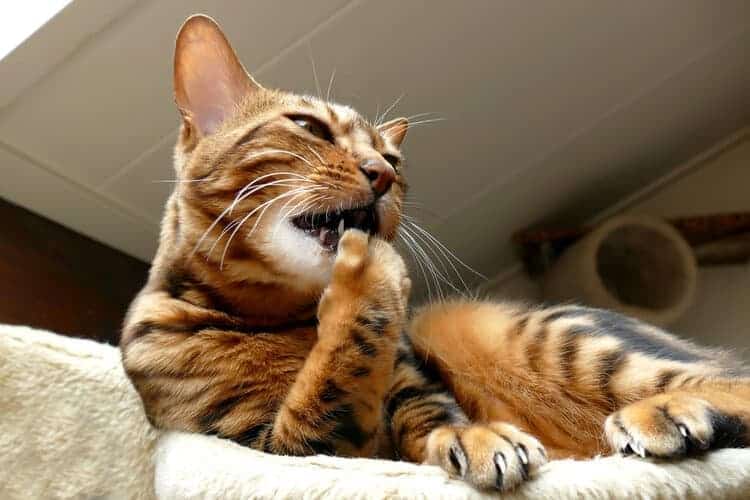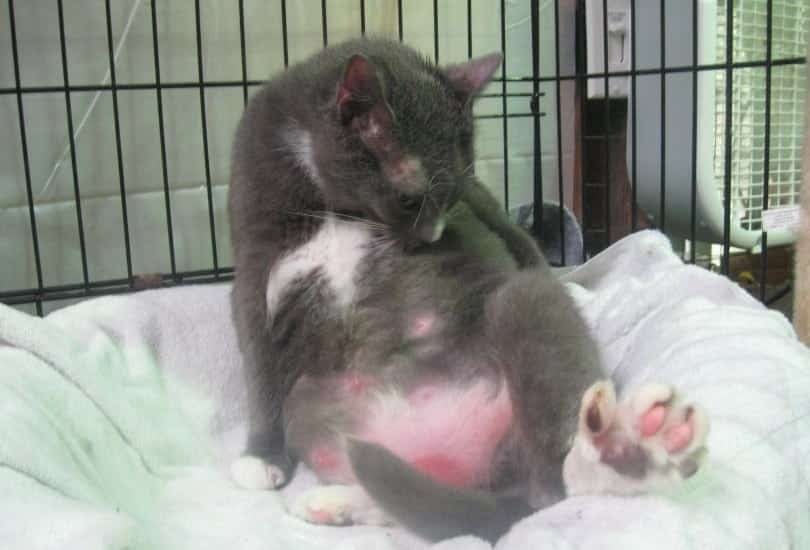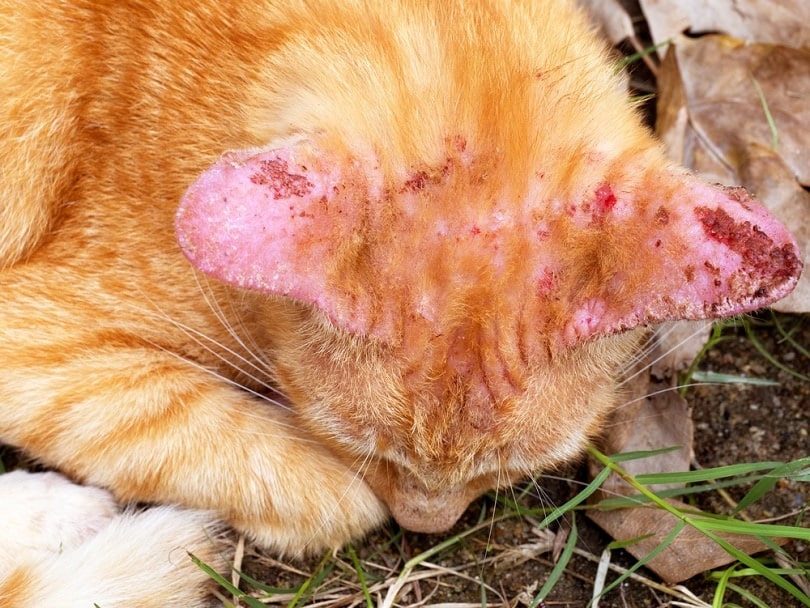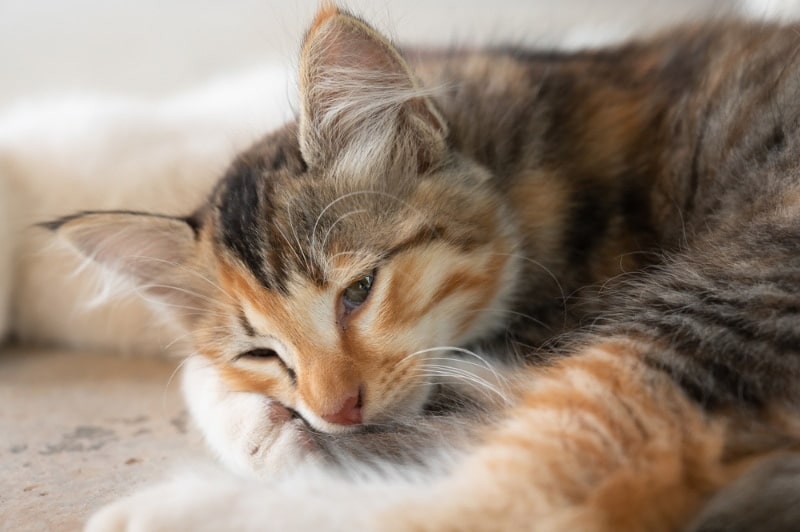Cats can spend as much as 50% of their day grooming themselves. They do it primarily to maintain themselves clean, but grooming also helps regulate their body temperature and spreads oils through their coat, to call a number of reasons. Cats also are likely to groom one another for bonding purposes. Nonetheless, grooming can turn out to be excessive and/or troublesome for various reasons.
For instance, a cat might start to tug their very own hair out. In the event you notice that your cat is doing this, you’re likely wondering why and whether it’s something to fret about. There are a number of reasons that your cat could be pulling out their hair. What to do about it is dependent upon the cause.

Know If Your Cat Is Excessively Grooming and Pulling Out Their Hair
It could be tough to inform whether your cat is grooming themselves to the purpose that they’re pulling out hair. Simply because you discover a patch of fur on the bottom doesn’t necessarily mean your cat has an issue with pulling their hair out. Nonetheless, in case you’re finding multiple chunks of hair lying around where your cat has been grooming themselves, likelihood is that there’s a hair-pulling problem to deal with.
One other sign that your cat is excessively grooming is that they begin to develop patches of baldness and/or obvious hair loss throughout their body. Even one bald patch is cause for concern. Excessive furball regurgitation is one other sign of excessive grooming. Finally, you may simply notice that your cat is grooming more often than usual.
 Image Credit: Ilona Koeleman, Shutterstock
Image Credit: Ilona Koeleman, Shutterstock

 The 7 Reasons That Your Cat Is Pulling Their Hair Out
The 7 Reasons That Your Cat Is Pulling Their Hair Out
1. Fleas and Flea Allergies
Fleas normally cause skin itchiness in felines, which can lead to excessive grooming and hair loss. Even indoor cats can get fleas, and it doesn’t take lots of them to cause problems. Unfortunately, it might be tough to rid a kitty of fleas and alleviate their itchiness. Flea treatments are vital immediately, and monthly ongoing ones are required to maintain the pests away for good. Your veterinarian can recommend an efficient flea control regimen.
Some felines develop flea allergy dermatitis, which principally means they’re allergic to flea saliva. Probably the most common manifestation of flea allergy dermatitis is skin itchiness. As your cat itches their skin, they pull hair out in the method. The answer to this problem is to stop flea infestations through regular veterinary prescribed flea treatments.
2. Other Allergies
 Image Credit: Goathouse Refuge, Flickr
Image Credit: Goathouse Refuge, Flickr
Cats may develop allergies at any time during their life. Allergens include foods, pollen, and house dust mites. Unfortunately, many cat allergies cause skin itchiness that may end up in overgrooming and hair loss. Veterinarians will follow a step-by step approach to research possible allergies, because the signs will be just like many other skin conditions. From there, a plan for allergy relief and maintenance will be created.
3. Mites
Mites are tiny parasites that infest the skin and hair follicles of cats, which usually results in problems like skin irritation, redness, itching, and even hair loss. Cheyletiella and demodex are two varieties of mites that may affect a cat’s skin. Demodex mites will be harder to detect because they live inside the hair follicles, whereas cheyletiella mites live to tell the tale the skin’s surface.
4. Ringworm
 Image Credit: Ameena Matcha, Shutterstock
Image Credit: Ameena Matcha, Shutterstock
While ringworm might sound like a parasite, it is definitely a fungal skin infection that may cause hair to fall out. These bald patches are sometimes scaly and sometimes look red and inflamed. It’d appear to be your cat is pulling their hair out, but it surely’s the fungal infection causing the hair loss. Ringworm is generally diagnosed by fungal culture of a sample of the hair and scale. Your veterinarian may recommend topical washes and oral medication to treat the infection.
5. Stress and/or Anxiety
Psychological problems like anxiety and stress may cause self-inflicted hair loss in felines, as they are going to try to search out relief through chewing, pulling, and excessively grooming their hair. Moving to a brand new home, introducing a brand new animal or baby to the family, being boarded for a period, and even competing with other cats within the household can all cause stress and/or anxiety in a feline.
This psychogenic overgrooming is far less common than other causes of comparable signs resembling allergy. It’s imperative to rule out other causes of overgrooming after which attempt to determine the reason behind the stress or anxiety so it might be addressed and eliminated if possible.
6. Boredom
 Image Credit: Kginger, Shutterstock
Image Credit: Kginger, Shutterstock
In an identical method to stress causing overgrooming, boredom also can cause a cat to tug their hair out, although this can be an unusual reason behind the issue. Cats are intelligent and an absence of environmental and mental stimulation can produce feelings of depression and overall lethargy. So, a feline might try to alleviate these feelings by overgrooming and pulling out their hair.
Introducing recent stimulants, resembling cat scratchers, towers, caves, and toys, can assist greatly reduce a cat’s boredom and proper their overgrooming and hair loss problem. If the problem persists, a visit to the veterinarian to rule out other possible causes of the hair loss is a great idea.
7. Pain
Unlike humans, cats cannot verbally tell anyone after they are in pain. They struggle to maintain their pain a secret because within the wild, it could be perceived as weakness by predators and enemies. Subsequently, you may not notice many signs of pain in your cat, but excessive licking that causes hair loss is something that shouldn’t be ignored.
Causes of pain may very well be anything from arthritis to an infection or injury. Diagnosing the rationale for the pain is step one in alleviating it, together with the hair loss and another problems.


Conclusion
There are several reasons that a feline could be pulling out their hair. The hot button is to find out the precise reason for it. You’ll need the assistance of a veterinarian to diagnose the cause so it might be effectively addressed and avoided in the long run.
Featured Image Credit: Dmitry Tkachuk, Shutterstock

